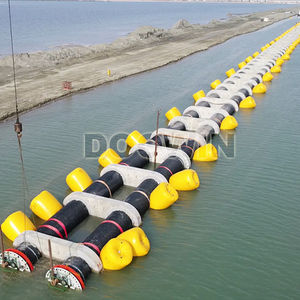
- Sailing
- Sailing Equipment and Gear
- Inflatable float
- DOOWIN - Underwater Lift Bags & Water Weight Bags
Pipeline float Tie-in Pipeinflatable

Add to favorites
Compare this product
Characteristics
- Applications
- for pipelines
- Other characteristics
- inflatable
Description
The pipe-laying floats can be strapped to the pipeline to reduce the tension and weight as pipe deployment floats. The pipe-laying floats also can be used to provide the buoyancy when pulling the pipeline underwater.
Tie-in Inflatable Pipe Laying Floats
Inflatable pipe float is one kind of arc-shaped pipeline laying buoys. This type of pipe float buoys can connect with the pipe closer to get more buoyancy in the shallow water condition. They can be adapted to the various pipe diameters. The buoyancy is from 1ton to 10 ton each unit.
Tie-in pipe floats have several lifting webbing slings. So pipe laying floats can be strapped to the pipeline. These pipe floats are used to break down the immersion velocity during pipe laying operations, as well as avoiding excessive bending of the pipes at the time of deployment at sea.
Features and Advantages of Tie-in Pipe Buoys
DOOWIN pipe floats are designed depending on the different diameter, working water depth, and project’s requirements. We can make the paral type, oval type, and other non-standard type buoyancy module upon the client’s request.
These pipe floaters buoys are widely used for the pipeline laying work because of it’s below advantages and features:
It can provide higher buoyancy at the same water depth
Different diameter design for various diameter pipe
Easy to install and remove
Equipped with the auto pressure release valve
Customized size available
Easy storage and transport
VIDEO
Catalogs
No catalogs are available for this product.
See all of DOOWIN - Underwater Lift Bags & Water Weight Bags‘s catalogsExhibitions
Meet this supplier at the following exhibition(s):

Other DOOWIN - Underwater Lift Bags & Water Weight Bags products
Air Lift Bags
Related Searches
*Prices are pre-tax. They exclude delivery charges and customs duties and do not include additional charges for installation or activation options. Prices are indicative only and may vary by country, with changes to the cost of raw materials and exchange rates.












